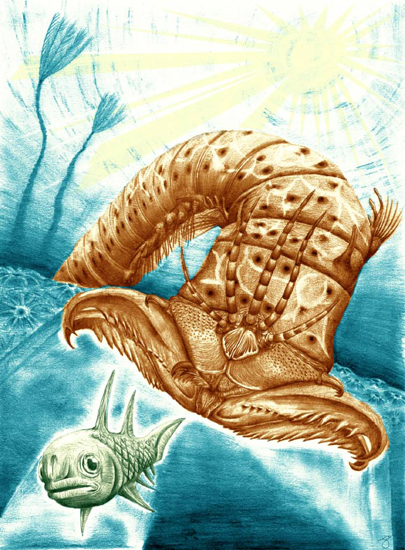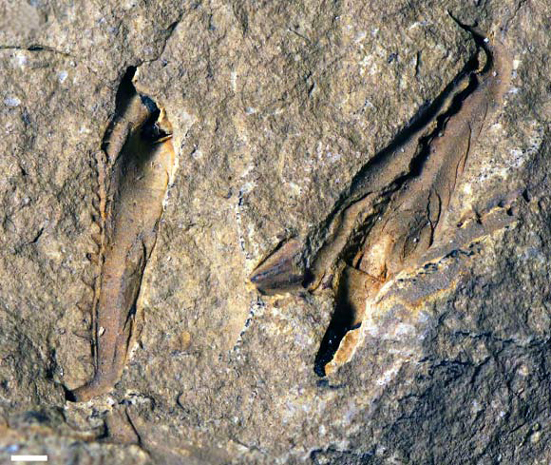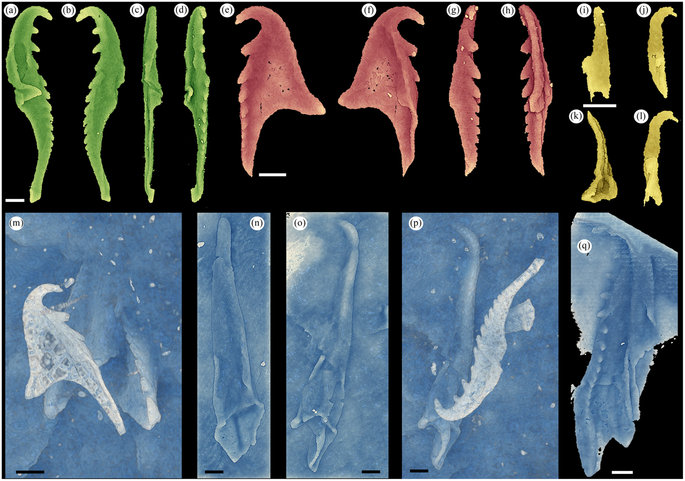Giant Devonian Worms and Death Metal
A new species of Devonian worm, a giant with fearsome jaws looking like something from a science fiction film, has been named and described by an international team of scientists. Researchers from Bristol University, Lund University (Sweden) and the Royal Ontario Museum (Canada), have named the beast Websteroprion armstrongi, the genus name honours Alex Webster the bassist in the Death Metal band Cannibal Corpse.
Websteroprion armstrongi
Websteroprion armstrongi – Attacking a Primitive Devonian Fish
Picture credit: James Ormiston
For models and replicas of prehistoric creatures: Prehistoric Animal Figures and Replicas.
A Polychaete Worm
Writing in the journal “Scientific Reports” the researchers identify the creature as a type of polychaete worm (Order Eunicida). Polychaete worms, often referred to as bristle worms, have a fossil record that can be traced back to the early Cambrian. Their soft bodies are rarely fossilised but the jaw elements, often just a millimetre or so in length, are made from hardened material (sclerotin) and they fossilise quite readily. In contrast, the fossil jaws of this species are nearly 13 millimetres long, making it a giant amongst these types of worms.
Eunicid polychaete worms are characterised by a dorsal pair of mandibles which contain toothed, maxillary plates. These plates are used to grasp prey, the scientists conclude that this new species of Devonian worm was also a predator, although the absence of any defined gut contents has prevented the team from making further comments with regards to this animal’s potential diet.
Although the scientists, which included lead author Mats Eriksson (Lund University), cannot be certain how big W. armstrongi was, they have estimated that it was probably over a metre in length. It has been postulated that this worm might have fed by ambushing small fish, arthropods and cephalopods by shooting out of its burrow and grasping its victims in its hook-like jaws that were lined by rows of sharp, tooth-like structures.
The jaws are the largest known in the Class Polychaeta.
Mats Eriksson commented:
“Gigantism in animals is an alluring and ecologically important trait, usually associated with advantages and competitive dominance. It is, however, a poorly understood phenomenon among marine worms and has never before been demonstrated in a fossil species. The new species demonstrates a unique case of polychaete gigantism in the Palaeozoic, some 400 million years ago.”
Fossils from a Remote Location
All the fossils that led to the naming of this new species, were collected in just a few hours in June 1994, Derek K. Armstrong, a geologist with the Ontario Geological Survey had the opportunity to visit a remote and rarely exposed portion of the sedimentary rock formations that made up part of the Hudson Platform located in the Hudson Bay Basin. The samples he collected proved to be Late Emsian-Early Eifelian (Early-Middle Devonian) age from the Kwataboahegan Formation and they were stored at the Royal Ontario Museum, until the authors decided to take a closer look at the fossil material.
Co-author Luke Parry (Bristol University) said:
“It also shows that gigantism in jaw-bearing polychaetes was restricted to one particular evolutionary clade within the Eunicida and has evolved many times in different species.”
Fossil Mandibles of Websteroprion armstrongi
Picture credit: Luke Parry (Bristol University)
The picture above shows specimen number ROM63122 lit so as to give the fossils a positive relief, the scale bar is 1 mm. The fossil on the left of the photograph is a maxilla from the left side of the animal. The fossil on the right is a maxilla from the right side.
David M. Rudkin (Dept. of Natural History at the Royal Ontario Museum), explained that there might be several, as yet not described species of Palaeozoic invertebrate, “hiding within plain sight”, amongst the museum’s extensive fossil collection.
He added:
“This is an excellent example of the importance of looking in remote and unexplored areas for finding new exciting things, but also the importance of scrutinising museum collections for overlooked gems.”
Palaeontology Meets Death Metal
The species name honours Cannibal Corpse bassist Alex Webster, regarded as a “giant” when it comes to handling his instrument, according to the researchers. The species (trivial), epithet pays tribute to Derek K. Armstrong, who collected the fossils.
Luke Parry added:
“This is fitting also since, beside our appetite for evolution and palaeontology, all three authors have a profound interest in music and are keen hobby musicians.”
At an estimated one metre in length, this extinct species is comparable to that of extant “giant eunicid” species colloquially referred to as “Bobbit worms”.
CT Scans Reveals the Evidence of a Giant Eunicid Worm
Picture credit: Scientific Reports
Websteroprion armstrongi – A Serendipitous Discovery
The researchers conclude that the serendipitous discovery of multiple specimens from a monospecific assemblage in a limited number of fossil samples suggests that Websteroprion armstrongi was a common species at this particular part of the seabed, which went onto become strata within the Kwataboahegan Formation. The specimens likely represent a “snap-shot assemblages”, the remains of many individuals that were suddenly and rapidly buried by sediment.
Visit the Everything Dinosaur website: Everything Dinosaur.









Leave A Comment